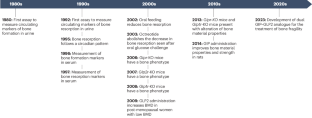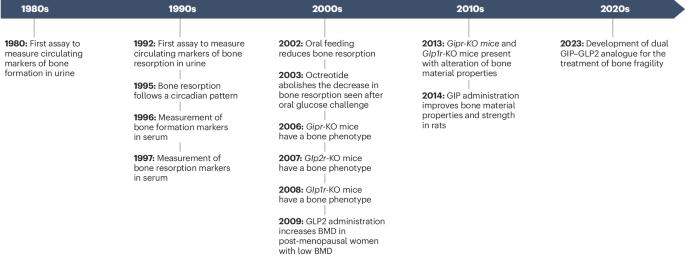Gut hormones and bone homeostasis: potential therapeutic implications
IF 31
1区 医学
Q1 ENDOCRINOLOGY & METABOLISM
引用次数: 0
Abstract
Bone resorption follows a circadian rhythm, with a marked reduction in circulating markers of resorption (such as carboxy-terminal telopeptide region of collagen type I in serum) in the postprandial period. Several gut hormones, including glucose-dependent insulinotropic polypeptide (GIP), glucagon-like peptide 1 (GLP1) and GLP2, have been linked to this effect in humans and rodent models. These hormones are secreted from enteroendocrine cells in the gastrointestinal tract in response to a variety of stimuli and effect a wide range of physiological processes within and outside the gut. Single GLP1, dual GLP1–GIP or GLP1–glucagon and triple GLP1–GIP–glucagon receptor agonists have been developed for the treatment of type 2 diabetes mellitus and obesity. In addition, single GIP, GLP1 and GLP2 analogues have been investigated in preclinical studies as novel therapeutics to improve bone strength in bone fragility disorders. Dual GIP–GLP2 analogues have been developed that show therapeutic promise for bone fragility in preclinical studies and seem to exert considerable activity at the bone material level. This Review summarizes the evidence of the action of gut hormones on bone homeostasis and physiology. This Review summarizes the evidence regarding the actions of gut hormones on bone homeostasis and physiology. The potential implications for the development of future therapeutics to treat bone fragility are considered.


肠道激素与骨平衡:潜在的治疗意义。
骨吸收遵循昼夜节律,餐后循环中的骨吸收标志物(如血清中 I 型胶原蛋白的羧基端端肽区域)明显减少。在人类和啮齿动物模型中,几种肠道激素,包括葡萄糖依赖性促胰岛素多肽(GIP)、胰高血糖素样肽 1(GLP1)和 GLP2,都与这种效应有关。这些激素由胃肠道中的肠内分泌细胞分泌,对各种刺激做出反应,并影响肠道内外的各种生理过程。目前已开发出单一 GLP1、双 GLP1-GIP 或 GLP1-Glucagon 以及三重 GLP1-GIP-Glucagon 受体激动剂,用于治疗 2 型糖尿病和肥胖症。此外,单一 GIP、GLP1 和 GLP2 类似物已作为新型疗法在临床前研究中进行了调查,以改善骨质脆弱症患者的骨强度。目前已开发出双 GIP-GLP2 类似物,它们在临床前研究中显示出治疗骨脆性的前景,并且似乎在骨材料层面发挥了相当大的活性。本综述总结了肠道激素对骨稳态和生理学作用的证据。
本文章由计算机程序翻译,如有差异,请以英文原文为准。
求助全文
约1分钟内获得全文
求助全文
来源期刊

Nature Reviews Endocrinology
医学-内分泌学与代谢
CiteScore
42.00
自引率
0.70%
发文量
158
审稿时长
6-12 weeks
期刊介绍:
Nature Reviews Endocrinology aspires to be the foremost platform for reviews and commentaries catering to the scientific communities it serves. The journal aims to publish articles characterized by authority, accessibility, and clarity, enhanced with easily understandable figures, tables, and other visual aids. The goal is to offer an unparalleled service to authors, referees, and readers, striving to maximize the usefulness and impact of each article. Nature Reviews Endocrinology publishes Research Highlights, Comments, News & Views, Reviews, Consensus Statements, and Perspectives relevant to researchers and clinicians in the fields of endocrinology and metabolism. Its broad scope ensures that the work it publishes reaches the widest possible audience.
 求助内容:
求助内容: 应助结果提醒方式:
应助结果提醒方式:


